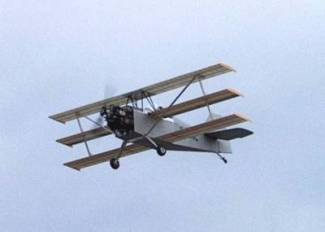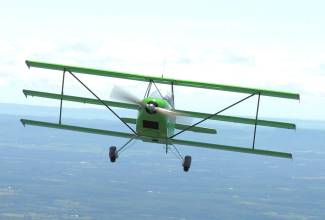

1T Triplane
| Main Page | Work in Progress Page 1 | Work in Progress Page 2 | Work in Progress Page 3 |
|
November 4, 2002 The Triplane is all ready to fly. The weight and balance is done and is within limits under fore and aft max loading conditions. The empty weight came out at 455 lbs which is very close to what we had predicted. We have run up the engine and did a few taxi tests. Now all we have to do is wait for Transport Canada to issue the required paper work. |
||

|

Completed - The completed aircraft ready to fly. |
|
|
November 30, 2002 IT FLYS! On a cold, dreary bleak day in November with light gusty winds the Acrolite 1T Triplane made its first flight. A very successful flight it was. A high speed taxi test down the runway to get the feel of the ground handling , another down the runway a few feet off the ground to check the response to flight controls, then line it up and go. The aircraft accelerates and lifts off the ground very quickly and climbout is exceptional. We were concerned that with the ailerons on only the center wing that the roll rate would not be adequate but this was not the case. Compared to the biplanes the aileron response is just a bit slow initially but once it starts moving it is quite good. It does not roll as fast as the biplanes but the turning radius is a lot smaller so I think it may just out turn the biplanes. The stall is more pronounced in the triplane and unlike the biplane that will fly itself out of a stall even with full back stick. the triplane requires proper stall recovery technique. In a 1000 ft climb out contest with the 80 hp biplane the triplane lagged only slightly behind. A full throttle, level flight, speed run showed 110 mph indicated at 6800 rpm, but I think that with the cowl and wheel fairings and some fine tuning of the prop it will go good bit faster than that. Typically on the biplanes the engine cowl and wheel fairings are good for an additional five mph. The triplane was test flown without the engine cowl, wheel fairings and final paint. We were not sure how it would fly and what changes might be needed to the airframe so they were left off until the initial flight testing was completed. Also we were running out of time and did not want to wait until spring to find out how it flys. As of this writing the triplane has over three hours on it by myself, Pete and Harold and it seems perfect just as it is. It flew hands off on the first flight with no changes required in trim. Visibility is very good, especially on approach and it feels easier to land than the biplanes because it does not seem to float as much at touchdown. Rudder authority is very good and it will make a really neat flat turn, just cut the throttle back to half, give it about ¾ rudder and it will do a 180 degree flat turn in the blink of an eye. We will try to get more flight testing in and some air to air photos before winter but it has turned very cold and unless we get some warmer weather before the snows come it looks like we are done until spring. |
||

|

4 Flyby pictures. |
|
|
June 1, 2005 The Triplane is finally finished. Over the past year we have done all the flight testing and we have competed the final painting. It looks real nice in its lime green and purple paint scheme. The polyurethane paint has a nice shine to it and the wings are very smooth. All of this is due to the many hours of hard work that Harold put in sanding and prepping the surfaces. His skill at painting and finishing is second to none. |
||
 Harold taxies out for a flight.
Cross country cruise. |
 How it looks head on.
The triplane in its final colors. |
|
|
ACKNOWLEDGEMENTS The development of the Triplane took 30 months. Five months to complete the drawings and stress analysis, six months to develop a wing construction system and complete the load testing and 19 months to build the aircraft. This is just a little longer than it took to develop and build the 1B biplane. Vern's passing slowed the project considerably, the wing frames were completed and the skins glued on two of them when he died so the finishing of the wings was left to the three of us. Vern worked on the airplanes constantly and was the driving force behind getting the planes completed in a timely manner. While Vern made the wings and Harold made all the fittings, did the covering, the electrics and the wiring and Pete welded the fuselage and installed the engine and engine systems, a lot of friends also helped out on the project. Vern's family – that let us have the use of Vern's shop and equipment to complete the wings. Adrian Tessier – did the top overhaul on the Rotax 582 engine. Shawn Donahue – built the wood turtledeck frame. Brian Forsythe – made the fiberglas wheel fairings. Jean Wilson – sewed the covering envelopes and made the baggage compartment cover. Garry Boyer – kept the website up to date as best he could despite having a very large project of his own. All the members of the Kakabeka Falls flying club that gave encouragement throughout the project. |
||